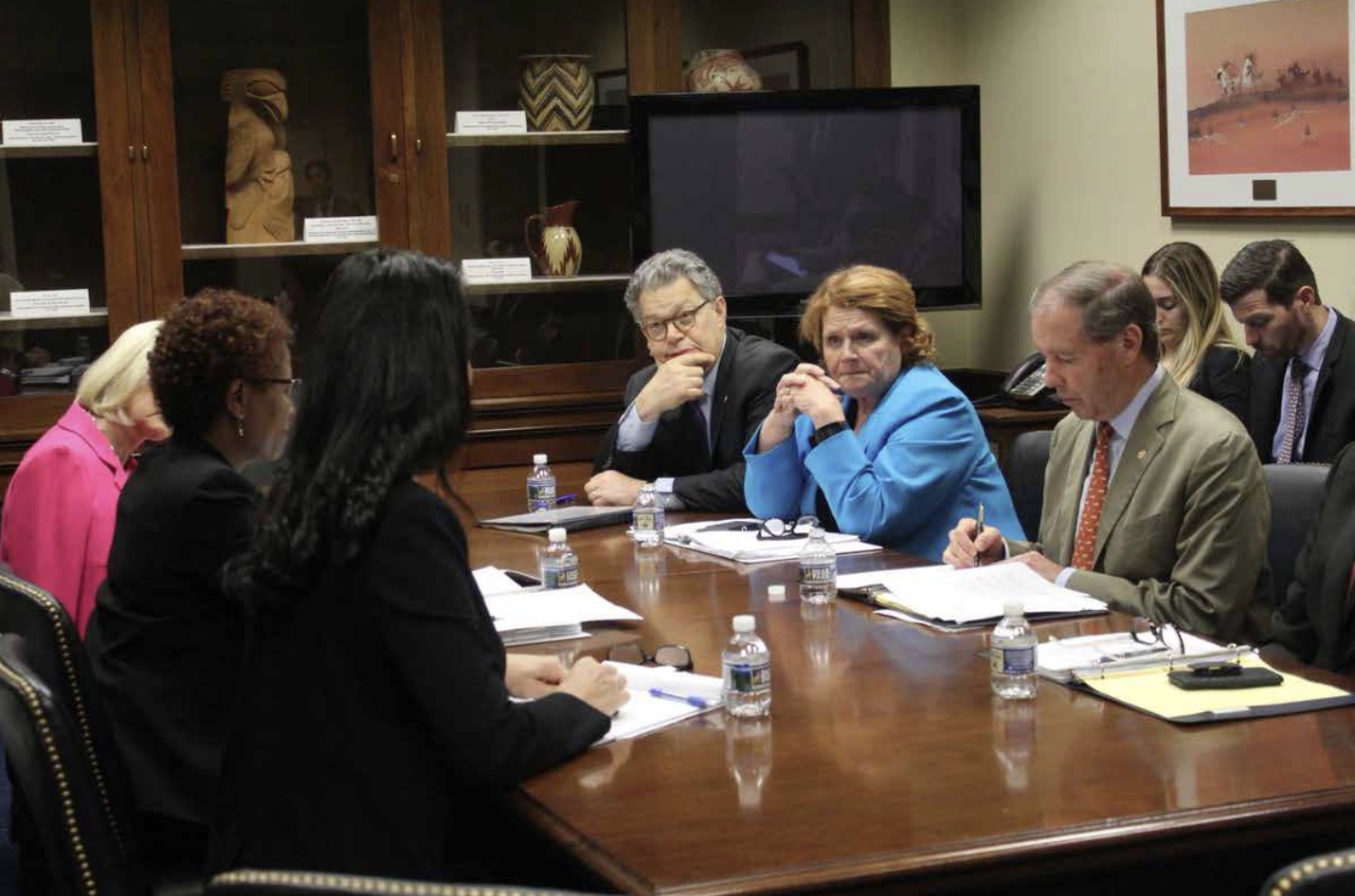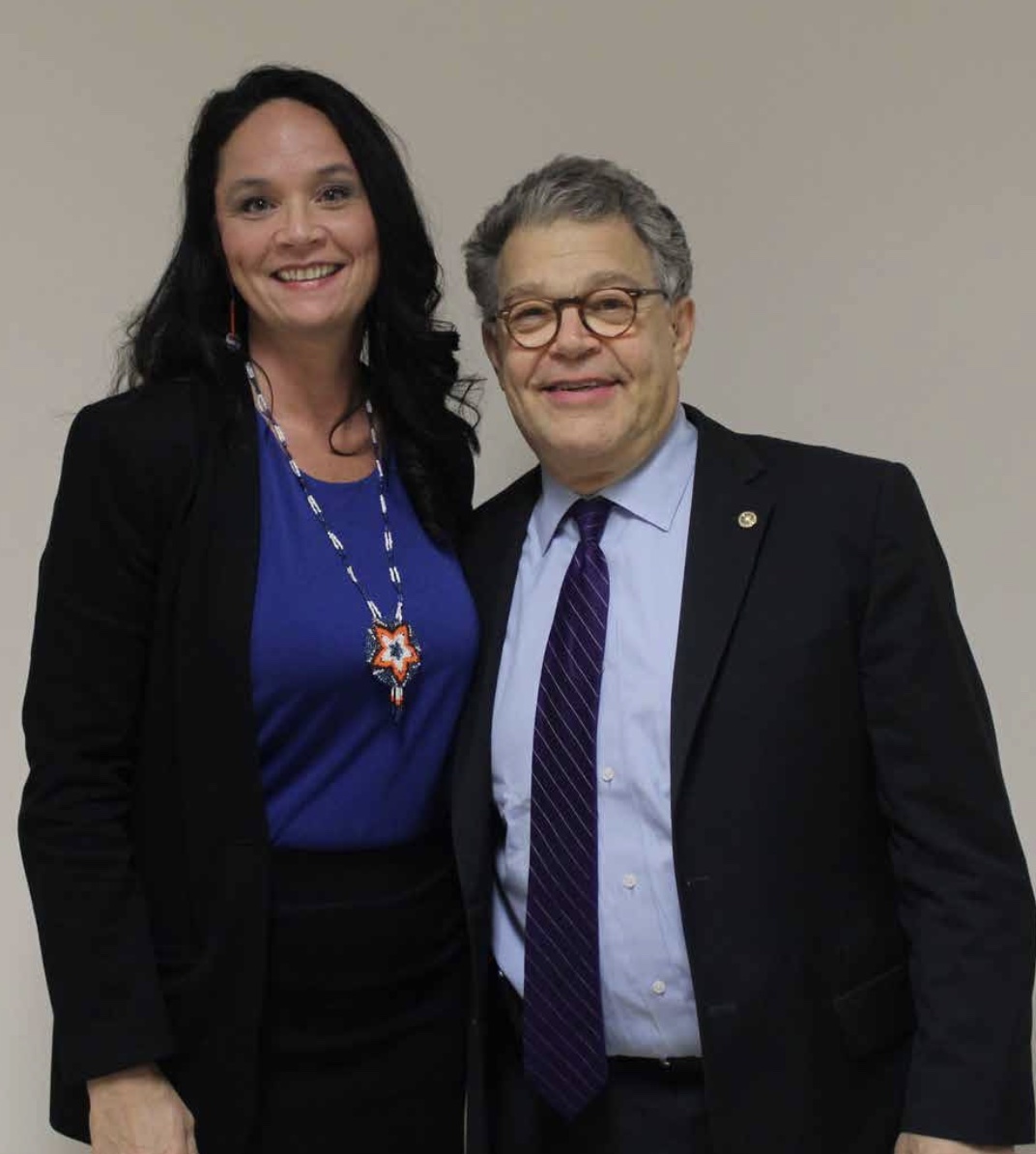Testimony before the US Senate, Committee on Indian Affairs on The GAO Reports on Human Trafficking of American Indian and Alaska Natives in the United States
United States Senate
Committee on Indian Affairs
The GAO Reports on Human Trafficking of American Indian and Alaska Natives in the United States
Testimony of Nicole Matthews,
Executive Director, Minnesota Indian Women’s Sexual Assault Coalition
September 27, 2017
Chairman Hoeven, Vice Chairman Udall, Senator Franken, and distinguished members of the Committee, Boozhoo Indinawe-maaganag! Nicole Matthews Zhaaginaashimong. Manidoo- Bineshiikwe indigo. Migizi indoodem. Gaa-waabaabiganiikaag indoonjibaa.
Greetings my relatives! My English name is Nicole Matthews, and my Indian name is Spirit Bird Woman. I am Eagle clan, and I am from the White Earth Band of Ojibwe.
I am truly honored to have the opportunity to speak with you today about human trafficking of American Indian and Alaska Natives in the United States.
I am the Executive Director of the Minnesota Indian Women's Sexual Assault Coalition, which is a statewide tribal coalition and a national tribal technical assistance provider. We provide technical assistance to Tribal Sexual Assault Services Program grantees, to tribes who are addressing or want to address sex trafficking, and we are the lead technical assistance provider for OVC’s Beacon Project, which addresses sex trafficking of American Indian and Alaska Native women in urban areas.
I was one of five interviewers for our research on prostitution and trafficking of American Indian and Alaska Native women in Minnesota, where we interviewed 105 American Indian and Alaska Native women about their experiences of being used in prostitution and trafficking. The title of our report is Garden of Truth: The Prostitution and Trafficking of Native Women in Minnesota.
The women we interviewed had been trafficked on and off the reservations; in urban and rural areas; and nearly all met the legal definition of trafficking. About 50% of the women said they gave most of their money to a pimp, and 86% of the women reported deception and trickery as their entry into trafficking.
We learned that oftentimes, historical trauma and childhood sexual abuse were a precursor or antecedent for the women who were used in trafficking. In fact, 79% of the women we interviewed were sexually abused as children, by an average of four perpetrators; and 67% of victims reported that they had family members who were sent to boarding schools, and most were abused in those boarding schools.
We also learned that the women faced incredible violence, including rape, physical violence, and racial violence. When we asked the women who they saw buying and selling American Indian and Alaska Native women, the overwhelming response was White followed by African American men. These statistics are consistent with federal Department of Justice reports on violence against American Indian and Alaska Native women, which state that the primary perpetrators of violence is perpetrated by non-Indian men.
 July, 26, 2017, Washington, DC—Nicole Matthews, Executive Director of the Minnesota Indian Women’s Sexual Assault Coalition, participated in a meeting with Senate Committee on Indian Affairs (SCIA) members to discuss two recent GAO Reports: “Human Trafficking: Action Needed to Identify the Number of Native American Victims Receiving Federally- funded Services,” and “Human Trafficking: Information on Cases in Indian Country or that Involved Native Americans. Pictured left to right: Senator Al Franken (MN), Senator Heidi Heitkamp (ND), Senator Tom Udall (NM). Senator Catherine Cortez Masto (NV), not pictured, also attended. The SCIA scheduled an Oversight Hearing on “The GAO Reports on Human Trafficking of Native Americans in the United States for September 27, 2017.”
July, 26, 2017, Washington, DC—Nicole Matthews, Executive Director of the Minnesota Indian Women’s Sexual Assault Coalition, participated in a meeting with Senate Committee on Indian Affairs (SCIA) members to discuss two recent GAO Reports: “Human Trafficking: Action Needed to Identify the Number of Native American Victims Receiving Federally- funded Services,” and “Human Trafficking: Information on Cases in Indian Country or that Involved Native Americans. Pictured left to right: Senator Al Franken (MN), Senator Heidi Heitkamp (ND), Senator Tom Udall (NM). Senator Catherine Cortez Masto (NV), not pictured, also attended. The SCIA scheduled an Oversight Hearing on “The GAO Reports on Human Trafficking of Native Americans in the United States for September 27, 2017.”
The victims we interviewed talked at length about their needs, which are consistent with the GAO reports that have been released this year. There is a need for culturally specific programs—by and for American Indian and Alaska Native women—to specifically address sex trafficking. Many victims are not accessing victim service programs for domestic or sexual violence because of perceived stigma and shame. The victims also fear losing their children or being arrested and charged with prostitution. Services also need to address housing; short-term and long-term housing is a huge issue for victims. In fact, 98% of the women we interviewed were currently or previously homeless. Being homeless is a major risk factor in being vulnerable to pimps and traffickers.
I am concerned with the GAO report finding that for the years of 2013–2016, there were only 14 federal investigations, and 2 federal prosecutions of human trafficking offenses in Indian Country. Only 2 federal prosecutions for this three-year period is disturbing given the reality of our research and information from those who we work with in tribal communities. The GAO report also highlights the lack of adequate resources to support culturally specific services for Native victims of trafficking. The report states that of the 45 grant programs that mention human trafficking as an allowable issue to devote resources to, only 2 address human trafficking in tribal communities exclusively. Given this minimally response to trafficking I am particularly concerned about the trafficking of Alaska Native women and girls given the lack of any law enforcement services and very limited services in many Alaska Native villages.
Twenty-one percent of the women we interviewed mentioned being trafficked on reservations, and since we know that the primary buyer and seller is non- Indian, we must address the jurisdictional challenges that prevents tribes from holding these perpetrators accountable. We need increased accountability for buyers and sellers and increased safety for American Indian and Alaska Native victims of sex trafficking. Nearly all of the women spoke of women they knew who had been taken by pimps and traffickers, and never heard from again.
There are also major gaps in the information that is available. We have heard anecdotal information about the high rates of trafficking of our Two Spirit/LGBTQ relatives, but there isn’t any concrete data to tell the full story yet. Our organization has been in communication with the researcher from our project, and we are hoping to address this need in the near future. Our Two Spirit relatives are even further invisibilized and harmed by trafficking, and we each have a responsibility to be good relatives and ensure that we are doing everything we can to address the violence experienced by ALL of our relatives and community members.
Another gap in data is around labor trafficking. We know that it is happening, and that it is occurring in some communities more than others, but we don’t have data to provide a full understanding of the problem.
I invite each and every one of you to reach out to the Native community—to meet with and listen to American Indian and Alaska Native victims and survivors of trafficking. They can teach us so much, and we must be open to listening to them as we continue to address human trafficking of American Indian and Alaska Native women.
In closing, I want to end with a quote from one of the survivors that we interviewed for our Garden of Truth report. In our research, the women chose flower names as their identifiers, and this woman chose the name Violet. Violet was kidnapped at age 12 and taken to another state where she was trafficked. She said, “Women like myself need someone they feel they can trust without being judged by how they lived their life. We didn’t wake up and choose to become a whore or a hooker or a 'ho’ as they call us. We need someone to understand where we came from and how we lived and that half of us were raped, beat, and made to sell our bodies. We need people with hearts.”
Miigwetch Bizidawiyeg! Thank you all for listening!

—Nicole Matthews.





